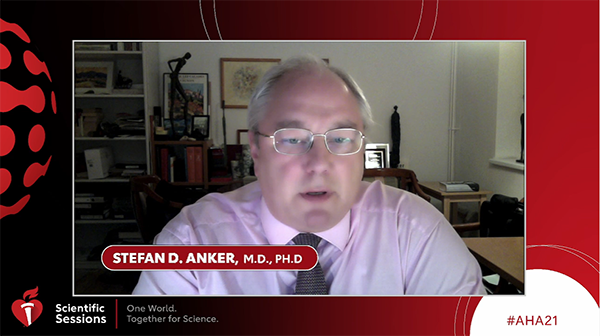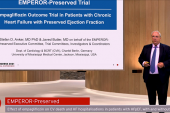Empagliflozin Retains Benefits in ‘True’ HFpEF Patients
An analysis of the EMPEROR-Preserved trial affirmed a wide-ranging impact in patients with LVEF ≥ 50%.

Empagliflozin (Jardiance; Boehringer Ingelheim/Eli Lilly) provides a wide range of benefits in patients with “true” heart failure and preserved ejection fraction (HFpEF) , meaning an LVEF of 50% or greater, EMPEROR-Preserved investigators report.
The main results of the placebo-controlled trial, released over the summer, showed that the sodium-glucose cotransporter 2 (SGLT2) inhibitor lowers the risk of CV death/hospitalization for heart failure in patients with HFpEF. But some commentators questioned whether EMPEROR-Preserved was truly a trial of HFpEF because it included patients with ejection fractions between 41% and 49%—considered “midrange” or “mildly reduced” in practice guidelines.
To address that uncertainty, the trial investigators performed a detailed analysis of patients with an LVEF of 50% or higher. Stefan Anker, MD, PhD (Charité – Universitätsmedizin Berlin, Germany), presented the results during a late-breaking science session at the recent virtual American Heart Association 2021 Scientific Sessions.
The analysis demonstrates that empagliflozin maintains its benefits in terms of hard clinical outcomes, quality of life, symptom status, and kidney function.
“Here we have a successful trial overall but also a successful trial for this specific population that is now considered the HFpEF population by most recent guidelines, with 50% and higher ejection fraction,” Anker concluded during his presentation.
Empagliflozin had previously proven successful in patients with heart failure and reduced ejection fraction (HFrEF) in the EMPEROR-Reduced trial, which included patients with an LVEF below 40%.
On that backdrop, this new analysis of EMPEROR-Preserved “extends our knowledge of the benefits of this agent, empagliflozin, across the wide range of left ventricular ejection fraction,” said study discussant Mary Norine Walsh, MD (St. Vincent Health, Indianapolis, IN), highlighting the fact that women made up half of patients enrolled in the trial who had an LVEF of 50% of higher. “Women are differentially disadvantaged by lack of information on guideline-directed medical therapy, so this is good news for our women patients.”
Importantly, the benefits of empagliflozin were not significantly attenuated at higher ejection fractions in this analysis, which contrasts somewhat with what was seen when the main results were presented back in August.
The take-home message, said Walsh, is that “clinicians who are busy can now refer less to ejection fraction” and focus more on “what the phenotype of their patient is with regard to whether or not they can use this important therapy. We don’t have to stop [and] reassess left ventricular ejection fraction with echocardiography or other imaging modalities before we decide what we need for our patients.”
Similar Effects Regardless of LVEF
EMPEROR-Preserved enrolled 5,988 patients with chronic HF, NYHA class II to IV symptoms, an LVEF greater than 40%, and either structural heart disease or a hospitalization for HF in the past year. Before getting randomized to empagliflozin or placebo, patients were stratified by baseline LVEF, and ultimately the trial included 4,005 patients with an ejection fraction of 50% or greater and 1,983 patients with an ejection fraction of 41% to 49%. That latter range “is considered maybe not so much heart failure with a preserved ejection fraction in the true sense,” Anker noted. In fact, the latest European guidelines considered EFs in that range “mildly reduced.”
In the patients with an LVEF of at least 50%, empagliflozin was associated with a significant reduction in the primary composite endpoint of CV death or first HF hospitalization (6.7 vs 8.0 events per 100 patient-years; HR 0.83; 95% CI 0.71-0.98). That was driven by a reduction in first HF hospitalizations (4.5 vs 5.7 per 100 patient-years; HR 0.78; 95% CI 0.64-0.95), with no significant difference in CV death.
The findings were similar in the patients with an LVEF of 41% to 49%, although the magnitude of the reductions in the primary endpoint and HF hospitalizations was greater than in patients with higher EFs. Moreover, there was a reduction in total HF hospitalizations (first and recurrent) with empagliflozin in this subgroup (HR 0.57; 95% CI 0.42-0.79), a difference that didn’t reach significance in the patients with an LVEF of 50% or higher.
Focusing specifically on the patients in the higher LVEF stratum, Anker reported that effects on the primary endpoint and total HF hospitalizations did not significantly differ across groups divided into smaller LVEF intervals ranging from 50% to < 55% up to 70% or higher (P = NS for both trends).
Improvements in quality of life based on the Kansas City Cardiomyopathy Questionnaire (KCCQ) and in NYHA functional class, as well as the slower decline in renal function, previously reported with empagliflozin versus placebo were consistent in the patients with an LVEF of at least 50%. The KCCQ findings were published earlier this week in Circulation.
Importance of Reducing HF Hospitalizations
Anker compared the EMPEROR-Preserved results in patients with an LVEF of 50% of higher with those from other HFpEF trials, noting that the significant 17% relative reduction in risk of the primary outcome was greater than nonsignificant reductions ranging from 4% to 8% seen in other trials.
Because PARAGON-HF, which compared sacubitril/valsartan (Entresto; Novartis) versus valsartan, enrolled patients with LVEFs greater than 50%, Anker and his colleagues performed an additional analysis comparing participants in that trial with EMPEROR-Preserved patients with similar LVEFs. That showed that empagliflozin reduced CV death/HF hospitalizations and first HF hospitalizations, but sacubitril/valsartan did not. “You may argue that PARAGON was an actively compared trial, but I would like to remind everybody that 79% of these patients [in EMPEROR-Preserved] already at baseline received [renin angiotensin system] inhibitors,” Anker said.
Discussion after the presentation turned to whether a reduction in HF hospitalizations is enough to warrant use of SGLT2 inhibitors in all patients with HFpEF, and Clyde Yancy, MD (Northwestern University Feinberg School of Medicine, Chicago, IL), who moderated the session, said it is.
“This is the first time we’ve had an evidence base that supports with any strength of data that we can uniquely change the natural history of heart failure with preserved ejection fraction, although we’re trying to redefine exactly what that means and at what threshold of ejection fraction,” Yancy commented. “But to know that we can attenuate morbidity, attenuate hospitalization—this is a meaningful outcome. And though we still need to find something that saves lives, we cannot overlook the fact that we can improve morbidity and we cannot overlook the fact that quality of life is better as well.”
Walsh ended her discussion by highlighting one barrier to access to SGLT2 inhibitors for patients in many parts of the world: high cost. “We need to continue to work on that,” she said.
Todd Neale is the Associate News Editor for TCTMD and a Senior Medical Journalist. He got his start in journalism at …
Read Full BioSources
Anker SD. Empagliflozin in heart failure with a preserved ejection fraction ≥ 50%. Presented at: AHA 2021. November 14, 2021.
Disclosures
- The EMPEROR-Preserved trial was funded by Boehringer Ingelheim and Eli Lilly.
- Anker reports fees from Abbott, Bayer, Boehringer Ingelheim, Brahms GmbH, Cardiac Dimension, Cordio, Novartis, Occlutech, Servier, and Vifor Pharma, as well as grant support from Abbott and Vifor Pharma.
- Walsh reports honoraria from EBR.





Comments